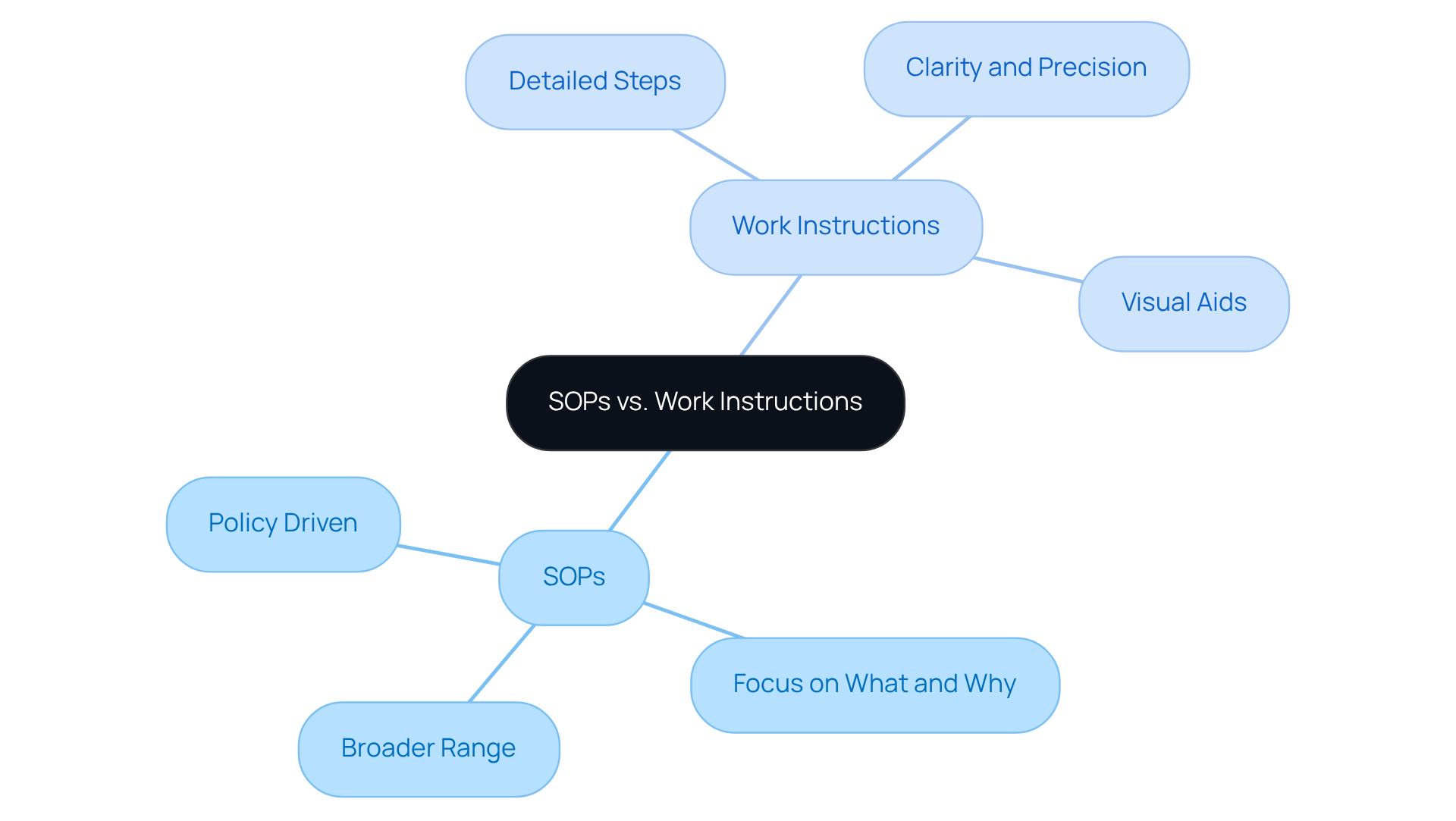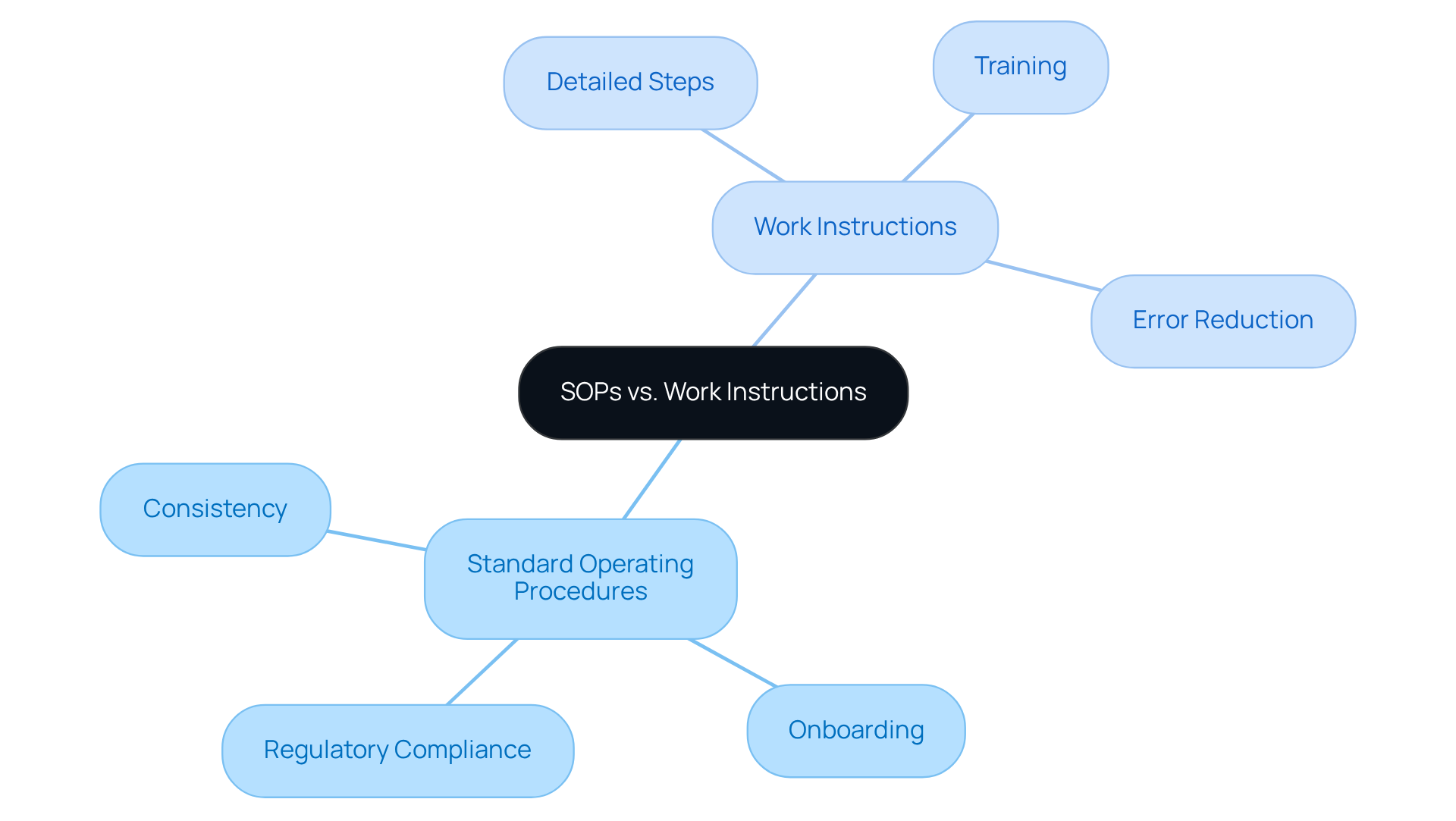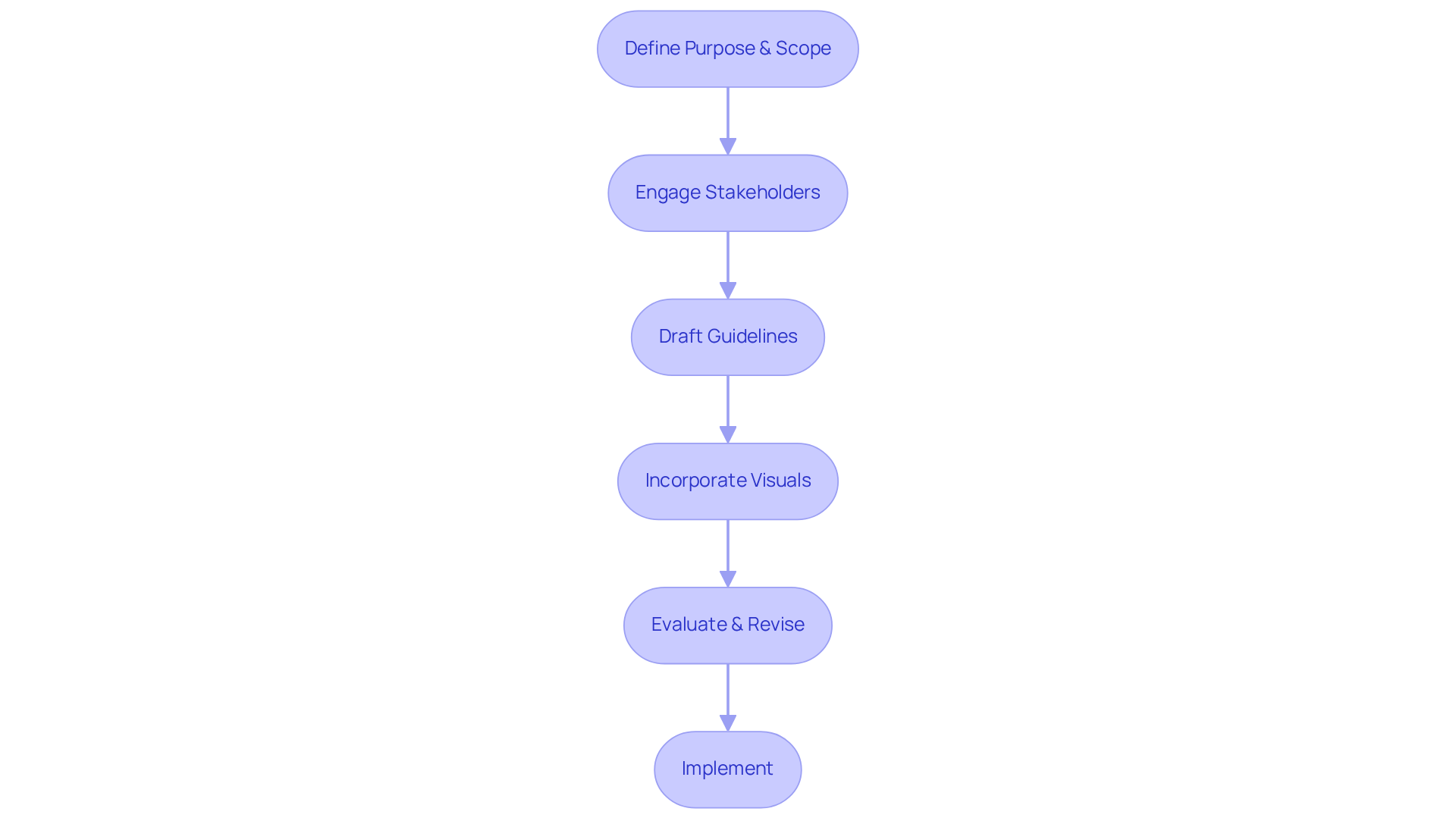
Remote Team Documentation Strategies
|
August 19, 2025
|
Understanding the Difference Between Standard Operating Procedure and Work Instruction
Overview
You might be wondering what sets Standard Operating Procedures (SOPs) apart from Work Instructions, right? Well, the main difference lies in their scope and purpose. SOPs give you a broader overview of processes, while Work Instructions dive into the nitty-gritty, offering detailed, step-by-step guidance for specific tasks. It’s like having a map versus having turn-by-turn directions!
Now, let’s break this down a bit. SOPs focus on the 'what' and 'why' of a process, ensuring that everything stays consistent and compliant. On the flip side, Work Instructions are all about the 'how.' They enhance clarity and operational efficiency by providing actionable steps and visuals that make it easier to follow along. So, whether you need a big-picture view or a detailed guide, both play crucial roles in effective documentation.
How do you currently approach your documentation challenges?
Key Highlights:
- SOPs serve as formal documents outlining steps for consistent activity execution across organisations.
- Operational Guidelines provide detailed, step-by-step directions within the context of an SOP.
- Effective documentation can lead to a 68% increase in operational efficiency and a 50% reduction in errors.
- SOPs focus on the broader 'what' and 'why,' while Work Instructions detail the 'how' for specific tasks.
- Using clear language in documentation is crucial for user understanding and compliance.
- SowFlow facilitates the creation and updating of SOPs and Work Instructions, enhancing their relevance.
- Regular updates to SOPs and Work Instructions are essential to adapt to changes in technology and regulations.
- Engaging stakeholders in the drafting process improves the effectiveness and acceptance of documentation.
- Incorporating visuals like flowcharts or diagrams enhances understanding and retention of procedures.
Introduction
You might be wondering why it’s so important to understand the nuances between Standard Operating Procedures (SOPs) and Work Instructions. Well, grasping these differences is crucial for organizations aiming for operational excellence. These documents are not just the backbone of efficient processes; they also play a significant role in compliance and productivity.
However, many people struggle to tell them apart, which can lead to confusion and inefficiencies. So, what are the key differences that can really elevate your organization’s operational strategy and ensure that every team member is aligned and informed? Let’s dive in!
Define Standard Operating Procedures and Work Instructions
You might be wondering why Standard Operating Procedures (SOPs) are such a big deal. Well, they’re essential formal documents that lay out the steps needed to carry out specific activities or processes consistently. Think of them as foundational guidelines for employees, ensuring everyone is on the same page when it comes to operations across the organization.
Now, let’s talk about Operational Guidelines. These offer more detailed, step-by-step directions for carrying out specific activities within the broader context of an SOP. They focus on the 'how' of a task, detailing the precise actions necessary for successful completion.
Together, the difference between standard operating procedure and work instruction creates a solid documentation strategy that can really boost operational efficiency and consistency. Organizations that implement these practices often see a whopping 68% increase in operational efficiency and a 50% reduction in errors and rework. That’s pretty impressive, right? It shows just how critical effective documentation is in streamlining business operations. Plus, industry leaders know that good documentation not only helps with compliance but also encourages a culture of continuous improvement, driving success in the organization.
Speaking of growth, did you know the Standard Operating Procedure Management Market is projected to expand at a CAGR of 11.25% between 2024 and 2031? This just highlights the increasing importance of SOPs in the sector. And here’s a thought: eighty-five percent of the reasons for failure come from deficiencies in systems and processes, not the employees themselves. This really underscores the importance of effective documentation. As Keyur B. puts it, 'Companies that use work instructions report a 68% increase in operational efficiency and a 50% reduction in errors and rework.' This reinforces how vital these documents are for achieving organizational success.
Lastly, let’s not overlook the importance of using straightforward language in standard operating procedures. It’s crucial for user understanding and compliance. So, if you’re in the documentation game, remember: clarity is key!

Differentiate Characteristics of SOPs and Work Instructions
You might be wondering about the difference between standard operating procedure and work instruction, right? Well, SOPs cover a broader range, tackling complete processes or systems while focusing on the 'what' and 'why' behind activities. These documents are often driven by policy, serving as a framework for compliance and consistency across your organization. On the other hand, Task Guidelines are all about the nitty-gritty details, providing clear, actionable steps for each specific task. They really prioritize clarity and precision, often using visuals or diagrams to make things easier to understand.
So, while SOPs lay out the big picture, Task Guidelines break everything down into manageable steps that employees can easily follow. This distinction highlights the difference between standard operating procedure and work instruction, which is super important because having effective procedures and guidelines together ensures operational efficiency and compliance with quality standards. Speaking of which, with SowFlow's instant documentation solution, creating and updating these essential documents becomes a breeze, keeping them relevant in our ever-changing business world.
SowFlow offers features like simple template design and real-time collaboration, which really streamline the process of crafting both SOPs and Task Guidelines. For instance, organizations that leverage comprehensive Procedures through SowFlow have seen significant performance boosts, with fewer errors and improved safety. Plus, regular reviews and updates are a cinch with SowFlow's user-friendly platform, which is key to maintaining the effectiveness of these documents. And don’t forget, keeping standard operating procedures up-to-date is crucial to reflect changes in technology and regulations.
Now, let’s not overlook Work Instructions! They're especially handy for new employees who need thorough guidance to manage their responsibilities efficiently. And guess what? SowFlow makes this process smooth and effective, ensuring everyone is set up for success.

Identify When to Use SOPs vs. Work Instructions
You might be wondering why Standard Operating Procedures (SOPs) are so essential. Well, they provide a comprehensive overview of processes, ensuring consistency across various tasks or departments. They’re especially handy when onboarding new employees, offering a structured framework that not only boosts compliance with regulations but also standardizes operations. When procedures are well-documented, they can really enhance job performance and build confidence among new hires, helping them become productive faster. With SowFlow's instant documentation solution, organizations can whip up and update SOPs effortlessly, keeping them relevant in today’s fast-paced business world.
Now, let’s talk about operational guidelines. These are perfect for specific tasks that need detailed, step-by-step direction. They really shine in training situations where clarity is key, particularly in settings where tasks can vary widely from one instance to the next. For instance, think about a work instruction that outlines how to assemble a product. This can be a game-changer for new employees, helping them navigate the process smoothly, reduce errors, and boost overall productivity. SowFlow makes it easy for teams to create these instructions quickly and effectively, ensuring they’re always up-to-date and accessible.
By understanding the context and needs of each situation, organizations can make the most of both standard operating procedures and the difference between standard operating procedure and work instruction. This strategic approach not only streamlines operations but also nurtures a culture of continuous improvement and knowledge retention, leading to better organizational performance. And don’t forget, regularly updating your standard procedures and guidelines is crucial to keep up with changes in regulations and enhance organizational resilience. With SowFlow, this process is a breeze, helping you avoid inefficiencies and strengthen your team.

Establish Best Practices for Creating SOPs and Work Instructions
To create effective Standard Operating Procedures (SOPs), you might be wondering about the difference between standard operating procedure and work instruction to figure out where to start. Well, it all begins with a clear definition of the document's purpose and scope. Engaging stakeholders in the drafting process is super important! Their insights help ensure that all relevant perspectives are included, leading to greater acceptance and adherence. Research shows that involving knowledgeable employees in SOP creation really boosts the effectiveness of the documentation, making it easier for everyone to embrace new procedures.
When you’re drafting those operational guidelines, clarity and simplicity should be your main focus. Break down tasks into manageable steps, using action-oriented verbs to guide users effectively. And don’t forget about visuals! Incorporating things like flowcharts or diagrams can really help with understanding and retention. Plus, it’s crucial to frequently evaluate and revise both SOPs and Task Guidelines. This keeps them relevant and precise, ensuring they adapt to any changes in procedures or regulations.
By following these best practices, organizations can develop documentation that clarifies the difference between standard operating procedure and work instruction, ensuring compliance while enhancing employee training and operational efficiency. You know, successful examples of organizations with clear Work Instructions show that investing time in creating these resources really pays off, leading to improved safety and productivity in the workplace. So, let’s dive into how you can make this work for you!

Conclusion
You might be wondering why it’s so important to understand the difference between Standard Operating Procedures (SOPs) and Work Instructions. Well, here’s the scoop: SOPs give you the big picture, laying out the 'what' and 'why' of your processes, while Work Instructions dive into the nitty-gritty 'how,' providing step-by-step guidance for specific tasks. Together, these documents are a game-changer for any organization looking to boost efficiency and create a culture of continuous improvement.
Let’s talk about some key points we've covered. Effective documentation can have a massive impact on operational performance—think about it, organizations have seen up to a 68% increase in efficiency and a 50% drop in errors! That’s huge! And it’s crucial to keep the language clear and update these documents regularly. This way, your team has all the info they need to nail their tasks. Plus, we touched on tools like SowFlow, which can make creating and maintaining SOPs and Work Instructions a breeze. Technology really can simplify these processes!
So, in wrapping up, using SOPs and Work Instructions effectively isn’t just about ticking boxes for compliance. It’s about empowering your employees and ramping up productivity. I encourage you to prioritize developing these documents, get your stakeholders involved, and focus on clarity and usability. By doing this, you’re not just improving outcomes; you’re also fostering an environment where continuous learning and improvement can thrive, paving the way for long-term success. Now, how exciting is that?
Frequently Asked Questions
What are Standard Operating Procedures (SOPs)?
Standard Operating Procedures (SOPs) are formal documents that outline the steps needed to carry out specific activities or processes consistently, serving as foundational guidelines for employees.
How do Operational Guidelines differ from SOPs?
Operational Guidelines provide more detailed, step-by-step directions for carrying out specific activities within the broader context of an SOP, focusing on the 'how' of a task.
What benefits do organizations see from implementing SOPs and work instructions?
Organizations that implement SOPs and work instructions often experience a 68% increase in operational efficiency and a 50% reduction in errors and rework.
Why is effective documentation critical for organizations?
Effective documentation streamlines business operations, helps with compliance, and encourages a culture of continuous improvement, driving overall success in the organization.
What is the projected growth of the Standard Operating Procedure Management Market?
The Standard Operating Procedure Management Market is projected to expand at a CAGR of 11.25% between 2024 and 2031.
What is a significant reason for organizational failures according to the article?
Eighty-five percent of the reasons for failure come from deficiencies in systems and processes, rather than the employees themselves.
What should be kept in mind regarding the language used in SOPs?
It is crucial to use straightforward language in standard operating procedures to ensure user understanding and compliance.
👍
What others are liking
5 Steps to outline your ideal documentation structure
5 MINS READ
Where to start the your journey of mapping out your ideal documentation structure, aligning it with the very heartbeat of your organization?
Defining a winning level of detail in your process
3 MINS READ
What is too much detail, and what is too little? This article described in that winning level detail about what detail is enough.





